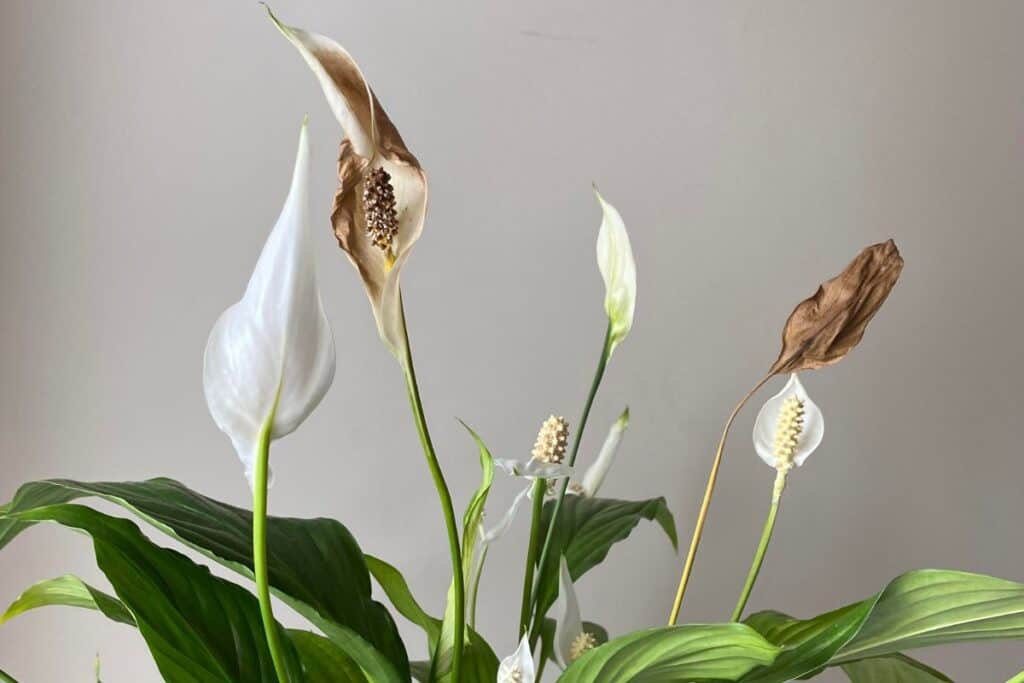Over 70% of Peace Lily issues come from watering mistakes, which means your plant’s warning signs are often easy to spot—if you know what to look for. Yellow leaves, brown tips, and drooping stems may seem similar, but they point to different problems. The key is learning how to read your plant’s unique combination of symptoms, check soil moisture, and understand how light, humidity, and root health all work together. Once you know what each sign means, you’ll stop guessing and start giving your Peace Lily exactly what it needs.

Contents
- 1 🍃 Why Are Your Peace Lily Leaves Discolored?
- 2 💧 Watering Mistakes and How to Fix Them
- 3 🐛 Spotting and Treating Pests
- 4 ☀️ Environmental Stress That Mimics Disease
- 5 🌱 Root and Soil Problems You Can’t See
- 6 🌬️ Fixing Humidity and Air Quality
- 7 🧪 Fertilizer Mistakes and How to Recover
- 8 🌾 Restoring Leaf Shape and Plant Posture
🍃 Why Are Your Peace Lily Leaves Discolored?
Leaf color changes are your plant’s way of asking for help. Here’s what different colors mean:
- Yellow leaves: Usually caused by overwatering (mushy roots) or underwatering (with brown tips)
- Spotted yellow leaves: May signal nutrient problems or pests like mealybugs
- Brown spots: Often caused by sunburn from direct sunlight
- Black leaves: Can mean disease, pests, or salt buildup from too much fertilizer
Start by checking soil moisture, then inspect the leaves—especially underneath—for pests. Adjust your watering, lighting, and fertilizing habits to bring back healthy green growth.
💧 Watering Mistakes and How to Fix Them

Watering is the #1 cause of Peace Lily problems, but it’s easy to fix with the right approach.
Overwatering signs:
- Mushy roots
- Yellow leaves
- Soil that stays wet for days
Underwatering signs:
- Droopy, curling leaves
- Brown tips
- Dry soil
Solutions:
- Check moisture by sticking your finger 2 inches into the soil
- Water from the bottom until the soil is fully soaked
- Keep soil moist but not soggy
- Use a pebble tray to boost humidity above 40%
🐛 Spotting and Treating Pests
Tiny bugs can cause big problems. Watch for:
- Yellow spots
- Brown patches
- Weak, drooping leaves
Check weekly under the leaves for pests like mealybugs, thrips, or spider mites.
Treatments:
- Neem oil for most pests
- Insecticidal soap for stubborn infestations
- Apply every 3 days until pests are gone
- Quarantine affected plants to stop the spread
- Keep inspecting regularly to catch future issues early
☀️ Environmental Stress That Mimics Disease
Sometimes your Peace Lily looks sick, but it’s just stressed by its environment.
Common stress triggers:
- Direct sunlight: Causes brown patches and leaf burn
- Cold drafts: Lead to wilting and yellowing
- Low humidity: Causes brown tips and curling
Fixes:
- Keep in bright, indirect light
- Move away from vents, doors, and drafty windows
- Use pebble trays or humidifiers to keep humidity above 40%
🌱 Root and Soil Problems You Can’t See
What’s happening below the surface matters just as much.
Root rot signs:
- Mushy, dark roots
- Foul smell
- Poor growth
Solutions:
- Repot immediately in well-draining soil
- Trim damaged roots with sterile scissors
- Use fresh soil with perlite or bark for better drainage
- Replace old soil every 1–2 years to avoid compacted, moisture-heavy conditions
🌬️ Fixing Humidity and Air Quality
Brown tips and curling leaves often mean your Peace Lily needs more humidity.
Tips to improve air and moisture:
- Use a small fan nearby (but avoid direct drafts)
- Place a pebble tray filled with water under the pot
- Group plants together to raise humidity naturally
- Use a humidifier if needed
- Check humidity with a gauge and aim for 40% or higher
🧪 Fertilizer Mistakes and How to Recover
Too much fertilizer can burn your Peace Lily’s roots and turn leaves black.
Signs of overfertilization:
- Black or dark patches
- Leaf discoloration
- Salt buildup in soil
Fixes:
- Flush soil with distilled water to remove excess salts
- Let water drain completely
- Feed monthly during growing season with diluted liquid fertilizer at ¼ strength
🌾 Restoring Leaf Shape and Plant Posture
Wilting, drooping, and curling leaves often mean your Peace Lily needs water—or less of it.
Quick fixes:
- Check soil moisture first
- If dry, bottom-water to fully soak the roots
- Leaves usually perk up within 2–3 hours
- If overwatered, stop watering and improve drainage
- Move the plant to bright, indirect light to help it recover
